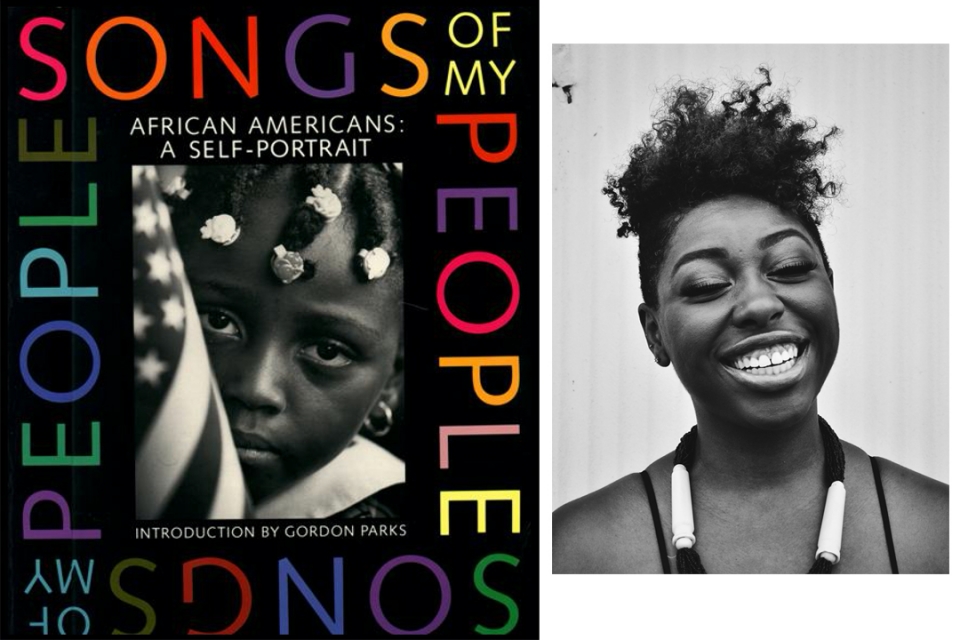In the early 1990s, thousands of African American photographers set out into their communities with cameras in their hands. Their task was to tell stories of black life and culture for a book and art exhibition called “Songs of My People: African Americans: A Self Portrait.” One of the most captivating images from the project was Keith Hadley’s powerful photo of Caroline Michel, a wide-eyed 9-year-old girl leaning into American flag.
Twenty-five years later, photographer and activist Reginald Cunningham snapped a portrait of a black woman in her 30s. She’s standing with her eyes closed, laughing in pure bliss. When School of Media and Public Affairs Professor Imani M. Cheers saw the photo, she instantly thought it illustrated what little Caroline Michel might look like today, 25 years after Mr. Hadley immortalized her through film.

School of Media and Public Affairs Professor Imani M. Cheers at the opening of "Songs of My People: 25 Years Later."
Mr. Cunningham’s image is a central piece of “Songs of My People: 25 Years Later,” a show that Dr. Cheers organized and curated at the George Washington University’s Gallery 102 to celebrate the 25th anniversary of the seminal ’90s exhibition.
“I gave the same assignment to my colleagues and my mentors—I said, ‘Would you take up the same path? Go out and document your communities, tell your truth, answer some of the questions that they attempted to answer with the original work. What does success look like? What does love look like in our communities? What do trials and triumphs look like?’” Dr. Cheers explained.

Images from “Songs of My People: 25 Years Later.” The exhibition is up now until March 3. (Logan Werlinger/GWToday.)
She was 10 years old when the her photojournalist father began working on the “Songs of My People” book with writer Eric Easter and photographer Dudley M. Brooks.
She remembers her father laying out images on the living room floor and developing film in the family’s dark room alongside famed photographer and documentarian Gordon Parks. When the book turned into an exhibition at the Corcoran Gallery in February 1992, Dr. Cheers recalls standing on the steps of the 17th Street Flagg building during the opening with her father. He made a trip back to familiar ground for a panel discussion in the Corcoran’s Hammer Auditorium when Dr. Cheers’ version of the exhibition debuted on Feb. 10. The panel also featured photographer and NYU professor Deborah Willis, National Museum of African American History and Culture curator Rhea Combs and Mr. Cunningham.
Like the 1992 exhibition, the photos in “Songs of My People: 25 Years Later” capture the nuances of black life and culture. Some are reflective of today’s turbulent political times and discussions of police brutality in black communities, such as Reese Bland’s shot of protesters holding the name of Sandra Bland, the 28-year-old black woman found dead in a Texas jail cell after being arrested for a minor traffic violation.

A photo by Reese Bland in the exhibition. (Image courtesy of Reese Bland)
Because Dr. Cheers also wanted to underscore ideas of leadership and moving policy forward in black communities, there are portraits of prominent figures like Brittany N. Packnett, the community organizer who served on President Barack Obama’s Task Force on 21st Century Policing. Other photographs are universal moments that speak to everyday life: There is a shot of a couple’s first wedding kiss, a woman going for a walk in Washington’s U Street neighborhood, a homeless man sitting in a park.
Dr. Cheers also included the perspectives of current and former GW students. Alumna Nana Agyemang, B.A. ’16, contributed a photo of two black women proudly wearing their natural hair, and second-year graduate student Zinhle Essamuah (who Dr. Cheers worked with for the recent documentary “The Minority Vote”) offered her image of President Obama giving a commencement address at Howard University in 2016.

"Black Love," a photograph taken by GW graduate student Zinhle Essamuah.
“There’s a theme in all of the things I’ve done as a professor, and it’s based in providing exposure and inclusiveness. People often don’t know and understand things not because they don’t want to, but because they simply aren’t exposed. So If I can present events and have discussions and showcase art…mission accomplished,” she said.
Her own role as an educator and professor has ties back to the work she remembers seeing in the original “Songs of My People.” One of the images that sticks out in her memory is her father’s own photograph of three black female doctors standing in their scrubs.
“At 12, seeing these women as doctors let me believe that I could become a doctor—and I did. Not a medical doctor like them, but my students call me Dr. Cheers,” she said. “That is a direct correlation with being 11 and seeing those images and understanding that this is not a far reach for anyone who looks like me. We can be anything we want to be.”

Top row: Njaimeh Njie, Monique Gamble, D. Michael Cheers, Rhea Combs and Reese Bland. Second Row: Zinhle Essamauh, Katina Douglas, Crystal Holmes, Imani M. Cheers, Deborah Willis and Reginald Cunningham.


